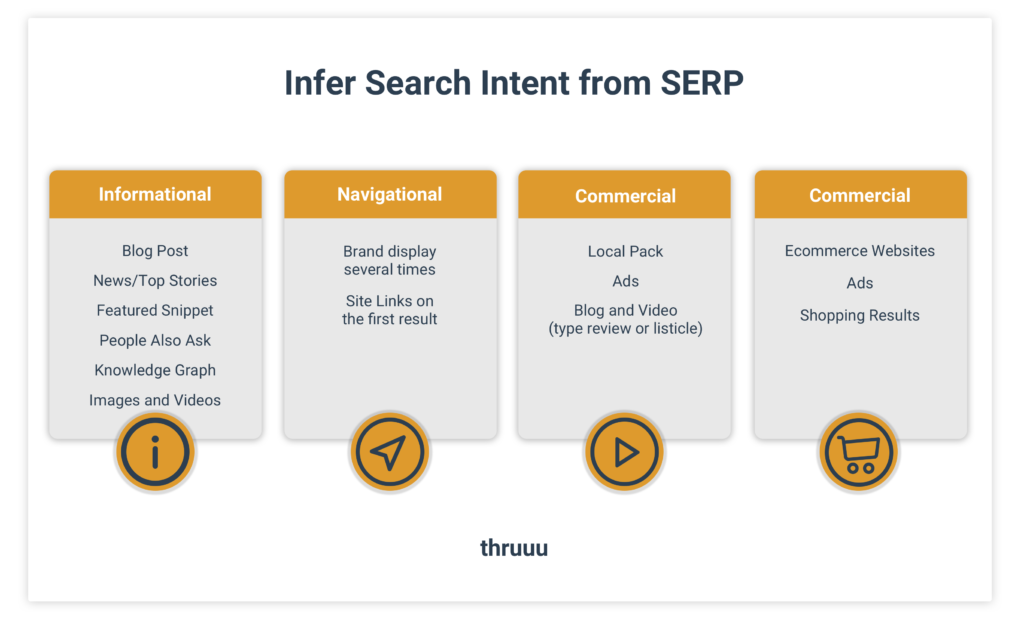Tube Rank: Your Guide to Video Success
Discover tips and insights for optimizing your video presence.
Decoding the Mysterious Mind of Search Intent
Uncover the secrets of search intent and boost your content strategy! Dive into the mind of your audience and enhance your SEO game today!
Understanding Search Intent: A Comprehensive Guide
Understanding search intent is crucial for optimizing your content to meet the needs of your audience. Search intent refers to the reason behind a user's query, which can range from seeking specific information to making a purchase. By categorizing search intent into types such as informational, navigational, transactional, and commercial, marketers can tailor their content strategies to align with these user motivations. For instance, a user searching for 'how to bake a cake' is likely looking for informational content, while someone searching for 'buy chocolate cake online' has a clear transactional intent.
To effectively capture and cater to search intent, it's key to integrate relevant keywords and provide content that directly addresses user queries. Conducting keyword research can help identify what users are asking and guide you in creating high-quality content that fulfills those needs. By implementing strategies such as optimizing meta descriptions, using headings appropriately, and creating engaging content that answers common questions, you can improve your site's visibility and relevance. In turn, this helps attract more organic traffic and ultimately leads to better engagement and conversions on your website.

The Psychology Behind Search Queries: What Users Really Want
The psychology behind search queries reveals a lot about what users truly desire when they type in keywords. At its core, a search query is a reflection of a user's intent — whether they are seeking immediate information, a product, or answers to complex questions. Understanding this intent is critical for content creators and marketers alike. Users typically fall into three categories: informational, navigational, and transactional. For instance, someone searching for "best smartphones 2023" is likely in the transactional phase, looking for options to purchase, while a query like "how to fix a leaking sink" indicates an informational need. Recognizing these patterns can help tailor content to better meet user needs.
Moreover, the emotional aspect of search queries cannot be overlooked. Users often search based on their feelings or situations, seeking solutions that resonate with their personal experiences. For example, a query like "how to overcome anxiety" suggests not only a demand for information but also an urgent need for support and guidance. It is essential for content creators to empathize with these emotions and provide value through their content. Using empathetic language, offering practical solutions, and presenting information in an engaging manner can significantly enhance user satisfaction and drive better engagement metrics, ultimately leading to improved SEO performance.
How to Optimize Your Content for Different Types of Search Intent
Understanding and optimizing your content for different types of search intent is crucial for attracting the right audience to your blog. There are primarily three types of search intent: informational, navigational, and transactional. To optimize for informational intent, focus on providing comprehensive answers to common questions in your niche. Use headlines and bullet points to break down complex information, making it easier for readers to digest and search engines to rank. Incorporating keywords naturally within your content will enhance your visibility for those seeking knowledge.
For navigational intent, where users are looking for a specific website or page, it’s essential to ensure your blog’s navigation is user-friendly and that key pages are easily accessible. Utilize metadata, such as title tags and meta descriptions, effectively to guide users. Lastly, when it comes to transactional intent, focus on persuasive content that encourages conversions. This can include strong calls to action, trust signals like customer testimonials, and detailed product descriptions that help potential customers make informed purchasing decisions.